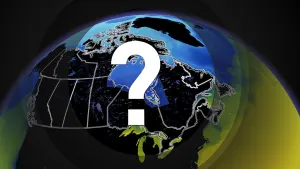
The complex future of food waste disposal
Experts say there is no 'one size fits all' approach to disposing of food waste.
Food waste is a big problem in Canada, where 58 per cent of all food produced in the country is thrown out annually. It isn't much better in the U.S., where about 40 per cent of the food supply winds up in the trash.
But landfills are in decline. As of 2016, there were between 1,900 and 2000 landfills in the U.S., according to the Environmental Protection Agency. That figure is down from 7,683 landfills in 1986, which represents a 75 per cent decline.
A sizeable amount of food waste ends up in the dump as opposed to the green, but Canada and the U.S. are making moves to ban organic waste in landfills, raising questions about where the additional waste will go.
Researchers are also looking into this, and according to a new report by the National Renewable Energy Laboratory (NREL), there's no clear cut answer.
Different regions will require different strategies, suggesting the future of food waste disposal will require multiple components.
"If we are trying to develop an optimized waste management system in the U.S. that diverts all food waste from landfills, there is not necessarily any one technology that will work for all areas of the country," NREL researcher and author of the report Alex Badgett said in a statement.
"An optimized system would likely use different technologies in different locations and at different sizes."
According to Badgett and co-author Anelia Milbrandt, about 75 per cent of food waste winds up in landfills, but many of these sites are running close to capacity, and some will be closing in 2050. In addition to the continued dumping of food in landfills, Badgett and Milbrandt propose four other viable options.
One of them is anaerobic digestion, which appears to be gaining popularity with some businesses in major cities like New York, which have already begun legislating how high volume food producers, like factories and restaurants, dispose of food waste.

Created in Canva by Cheryl Santa Maria using free/public domain graphical elements. More food tips here.
Some businesses are using anaerobic digesters, on-site devices that can be the size of a dishwasher or larger, depending on the need. Waste is placed in the digester, and a mix of microorganisms, water, and oxygen 'digest' it into a liquid that can be safely disposed of.
Badgett and Milbrandt also suggest incineration and hydrothermal liquefaction, where wet organic material is converted into a crude-oil-like material - but incineration raises environmental concerns, and hydrothermal liquefaction is still in its infancy.
The fourth option is tried and true and will be the likely option for many households: composting.
Badgett and Milbrandt's report point to the growing consensus that food waste disposal will be a complex and multi-dimensional process in the future. It signals an urgent need for producers, manufacturers, businesses, and individuals to reduce food waste - and for experts to perfect and further diversify disposal technologies.
BANNING FOOD WASTE IN LANDFILLS
Despite the current but somewhat limited options, Ontario plans to ban all organic food waste in its landfills by 2022, using a varied approach that includes expanding the items accepted in its green bins and working to reduce overall food waste.
The US Department of Agriculture is adopting a similar strategy, setting a goal to reduce national food waste by 50 per cent by 2030.
It's a lofty but important goal, given that climate change, humanitarian and natural disasters, and other factors are widening food disparities and creating a food shortage crisis.

Created in Canva by Cheryl Santa Maria using free/public domain graphical elements. More food tips here.
The reason experts are looking into new ways to dispose of food is because when it ends up in landfills, decomposing food releases methane - a gas that, according to MIT is estimated to be 25 times more potent than carbon dioxide over a 100-year period.
It also contaminates the ground and water with a substance called leachate, which seeps from landfill trash.
REDUCING FOOD WASTE
Governments and industries will need to work together to address the food waste disposal problem - but there are steps individuals can take to reduce food waste.
The Environmental Protection Agency recommends:
Planning your meals for the week and only buying ingredients required for those dishes.
When making a shopping list, include how many meals you can get out of each item to avoid overbuying.
Remember that buying in bulk only saves money if you use everything.
Learn how to keep your fruits and veggies fresh longer.
Freeze or preserve produce you won't be able to eat in time.
'Shop' your refrigerator and pantry before heading to the grocery store.
There's a difference between “sell-by,” “use-by,” “best-by,” and expiration dates. -
Confusion over this leads to significant food waste.
Take only what you can eat at buffets, potlucks, and social gatherings.
Thumbnail image courtesy: Getty.










